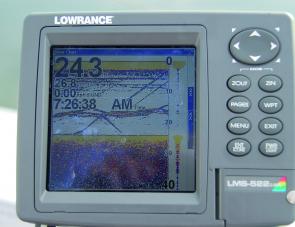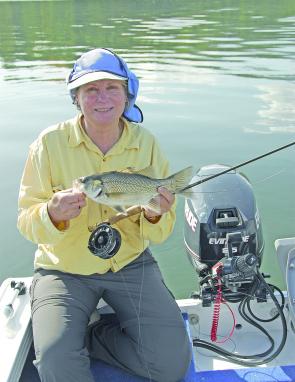Maroon's bass might not be as large as those of lakes Wivenhoe and Somerset, but what they lack in size they more than make up for in willingness to have a go.
Weed beds are prolific around Maroon Dam, which currently sits at 60%, and the presence of this weed has created a somewhat unique situation whereby the fly angler can enjoy some very spectacular surface fishing at first light or towards dark.
And make no mistake, this is unique. Wivenhoe and Somerset hold massive bass populations but try as one might it is very hard to enjoy early morning or evening surface action. The fish just don't feed in the shallows in sufficient numbers to make it worthwhile. At Maroon Dam, on the other hand, it's very easy to find a place where surfaces flies will be readily taken.
However, surface fishing is not the only mainstay of Maroon Dam's bass on fly activities. Once the sun is well on the water of a morning the fish will be cruising along the deeper edges of the weed beds, often at around the 6m mark or perhaps a little less and these fish can be very active as well.
All in all, the bass in this dam are willing starters; all the angler needs to do is to get set up in the right manner and it will come together nicely.
Maroon won't produce many bass over 40cm for the fly angler so a 6wt outfit will take care of both fish and casting of flies with ease. There is a need, however, for both sinking and floating fly lines. This is to cater for both styles of fishing if one wants to enjoy the dam's potential to its fullest.
I rely on a floating line with 3m leader (and 5kg tip) for surface work at daylight with either a sink tip or full sinking line when the sun is bright and the fish have deserted the shallows. A full sink leader around a rod's length will be best for deepwater fishing.
Suitable flies for surface work include the Gartside Gurgler, Grabhams' Gurgler, Dahlberg Diver and virtually any small popper one likes to try. Hooks need to be sharp and not overly large, size 1 is ideal. Surface feeding bass whack and splash a lot but if the hook is too big they won't stay connected for long.
Sinking flies that work well at Maroon include Bunny flies, such as the Leech and Zonker, or Woolly Buggers with dark green or chartreuse being hot colours. Size 1 or 2 is ideal.
This is the nitty gritty of Maroon Dam fishing, especially if you want to enjoy the thrill of surface fishing for these willing bass. It is important to be on the water just as it's light enough to see, and expect the fish to taper off after an hour or so depending upon cloud cover.
If possible, have a good hard look at the various bays and inlets in daylight. It's not hard to locate some weed beds that will have the all important channels about them and with sections that are around 20-30cm (or more) below the surface. These are the sort of areas that the fish like to patrol at dawn or dusk and the clue is to get the boat right onto the edge of a chosen weed bed or channel and simply cast up onto those sections where the weed is well submerged.
Once the fly lands, the key is to give it a couple of bobs or strips – just little ones, no big gurgles, these aren't barra – and watch while the fun happens. It won't take long for a bass to grab the fly and then if the angler is not on their game the little rascal will bury straight into the weed bed. This is why I advocate the heavier 5kg tippet for this style of fishing!
In an average morning's surface fishing we can expect up to a dozen fish having a go. Just how many the angler lands is a measure of skill and luck but the point is that the action will occur, which is great.
When the surface action tapers off, and remember that we don't actually need to see fish surface feeding for best results, the key is to head straight out off the weed bed and work the Leech or Woollys down deeper in very short but quite sharp strips. Staying with the 5kg leader will prevent break offs that can easily occur if a fish latches on hard right in the middle of a strip.
Standard deep fly tactics also work well in this dam. Simply find the fish on the sounder and get the chosen Vampire or Clouser Deep Minnow right to the bottom by counting the fly down – allow around 3.5 seconds per metre of descent for a Striper IV line – prior to commencing those little sharp strips that seem to catch bass out every time.
Flies with a predominance of red in them over the purple used elsewhere seem to be very good at Maroon Dam.
Most bass holding in deeper water in this dam seem to be at around the 6-6.5m depth range.
By-catch in the form of spangled perch is also on the cards, which all adds up to a great time with the fly rod.
Reads: 7283
Those lines on the sounder's screen represent feeding bass; once located the fish can be tempted with a deeply sunken fly.

Maroon Dam bass mightn't be large but there are plenty of them.

This is one pretty dam; a great place for a day in pursuit of bass.




